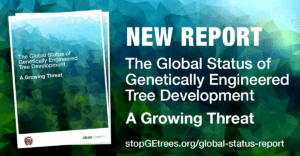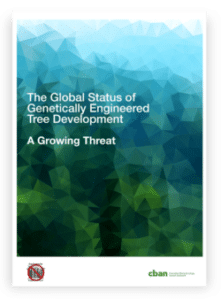GE Trees
The release of genetically engineered (GE or genetically modified) trees could have unpredictable and irreversible consequences. GE trees pose an even greater risk of contamination than seen with GE crop plants, because trees live for decades, have so many nearby wild relatives and their pollen travels hundreds of miles. The new proposal to purposefully release a GE American chestnut tree into the wild forests of Canada and the US poses unique and unknown risks to our forest ecosystems.
March 2025 – CBAN Factsheet: Proposed release of the genetically engineered American chestnut trees
Take Action
Subscribe for news and action on GE trees
Subscribe to CBAN’s newsletter on genetically engineered trees to receive updates and event notices.
Updates
August 2024: Genetically Engineered American Chestnut: Discussion of the performance limitations of Darling 58/54, Report by EcoNexus.
July 2024: Suzano’s Pulp Fiction: Comparing words and deeds of the world’s largest eucalyptus pulp producer, Environmental Paper Network. Read about the unsustainable, unjust practices of Suzano, the world’s biggest producer of eucalyptus pulp and one of the largest paper manufacturers in South America, which has invested heavily in developing genetically engineered trees (not yet commercialized).
February 2024 – Updated CBAN Factsheet: Introduction to the Genetically Engineered American Chestnut
February 20, 2024: The Canadian Chestnut Council and the Canadian Biotechnology Action Network have written to the State University of New York College of Environmental Science and Forestry (SUNY ESF) to ask them to withdraw their application for US government approval of the Darling 58 GE American chestnut, which is now shown to fail to perform as intended. Click here to read the letter.
 December 2023: The American Chestnut Foundation (TACF) will discontinue its development of the Darling 58 genetically engineered American chestnut due to significant performance limitations. However, the property right holders have not yet withdrawn their request to release this GE tree, which is still under consideration by the US Department of Agriculture. TACF Press Release: TACF Discontinues Development of Darling 58, The American Chestnut Foundation, December 8, 2023.
December 2023: The American Chestnut Foundation (TACF) will discontinue its development of the Darling 58 genetically engineered American chestnut due to significant performance limitations. However, the property right holders have not yet withdrawn their request to release this GE tree, which is still under consideration by the US Department of Agriculture. TACF Press Release: TACF Discontinues Development of Darling 58, The American Chestnut Foundation, December 8, 2023.
- CBAN Press Release: Researchers Disown Their Own Genetically Engineered Tree, December 13, 2023
- CBAN Background: GE American Chestnut Performance Failures, December 13, 2023
- CBAN Background: The Genetically Engineered American Chestnut, December 13, 2023
- Opinion Article:The American Chestnut Foundation Bails as GE Chestnut Develops Growth and Fertility Problems and Fails to Resist the Blight, Anne Petermann, Global Justice Ecology Project, December 15, 2023
- The American Chestnut Foundation has summarized the “significant performance limitations” of the GE tree called “Darling 58” in Darling 58 Performance Results, The American Chestnut Foundation, December 8, 2023
October 2023: International Bulletin: Genetically Engineered Trees, for critical updates.
 March 31, 2023: The Forest Stewardship Council (FSC) has decided to halt its proposed “Genetic Engineering Learning Process.” This process would have resulted in the FSC directly overseeing field tests of genetically engineered (GE) trees, and it would have started a path towards the FSC accepting GE trees in its certification program. On March 31st, 2023, FSC said: “The decision considered the different views in FSC’s membership around the learning process, the division this brings to FSC as well as the potential risk to FSC’s mission and reputation.” This strengthening of FSC’s prohibition on GE trees should help stop the release of GE glyphosate-tolerant eucalyptus trees in Brazil, as well as other GE trees. The FSC’s policy is an important obstacle to GE tree development globally. Press Release – April 4, 2023: Forest Stewardship Council Backs Away from Genetic Engineering Following Global Campaign Calling on them to Uphold their Ban on GE Trees.
March 31, 2023: The Forest Stewardship Council (FSC) has decided to halt its proposed “Genetic Engineering Learning Process.” This process would have resulted in the FSC directly overseeing field tests of genetically engineered (GE) trees, and it would have started a path towards the FSC accepting GE trees in its certification program. On March 31st, 2023, FSC said: “The decision considered the different views in FSC’s membership around the learning process, the division this brings to FSC as well as the potential risk to FSC’s mission and reputation.” This strengthening of FSC’s prohibition on GE trees should help stop the release of GE glyphosate-tolerant eucalyptus trees in Brazil, as well as other GE trees. The FSC’s policy is an important obstacle to GE tree development globally. Press Release – April 4, 2023: Forest Stewardship Council Backs Away from Genetic Engineering Following Global Campaign Calling on them to Uphold their Ban on GE Trees.
November 2022 – January 2023: The US Department of Agriculture has released a draft Environmental Impact Statement that recommends approving the unrestricted planting of genetically engineered (GE) American chestnut trees in wild forests. This comes despite the lack of information about the long-term risks to forests, biodiversity, communities or human health. If approved, this GE American chestnut tree (known as Darling 58) would be the first-ever genetically engineered forest tree planted outside field tests in North America. It would also be the first-ever genetically engineered plant released anywhere with the purpose of spreading freely through wild ecosystems.
- Action Alert: Comments needed to stop release of GE trees into wild forests, Deadline extended to January 27, 2023
- Opinion Article: That new chestnut? USDA plans to allow the release of GE trees into wild forests, The Hill, Donald Edward Davis, November 27, 2022
- CBAN’s Comments: CBAN’s comments to the USDA on the proposed release of the GE American chestnut “Darling 58”, December 22, 2022
 September 2022 – Report: The Global Status of Genetically Engineered Tree Development: A Growing Threat. The global release of genetically engineered trees is closer than it has ever been. This report examines the status of GE tree development around the world, to identify where the risk of GE tree release is most immediate. It also outlines some of the risks and discusses some of the most prominent proposed uses. Due to changes in national regulations, this report may be the last opportunity to get a snapshot of GE tree field testing around the world.
September 2022 – Report: The Global Status of Genetically Engineered Tree Development: A Growing Threat. The global release of genetically engineered trees is closer than it has ever been. This report examines the status of GE tree development around the world, to identify where the risk of GE tree release is most immediate. It also outlines some of the risks and discusses some of the most prominent proposed uses. Due to changes in national regulations, this report may be the last opportunity to get a snapshot of GE tree field testing around the world.
June 2022: Groups in Brazil a denouncing Brazil’s approval of a genetically engineered glyphosate-tolerant eucalyptus tree from the pulp and paper company Suzano. Read the statement here.
September 7, 2021 – Statement – Genetically Engineered Trees: No Solution to Climate Change: “Genetically engineered trees are not a climate solution. They are a dangerous distraction, and a threat to forests and communities that will worsen the climate crisis rather than fix it.” Published by the Campaign to STOP GE Trees.
Proposed Release of GE American Chestnut Trees
The US government is considering a request to allow the release of genetically engineered (GE or genetically modified) American chestnut trees into US forests. The GE trees could spread from US forests into forests in eastern Canada. Researchers say they will also ask the Canadian government to approve planting this GE tree in Canadian forests.
CBAN Factsheet – March 2025: Alert: Proposed Release of Genetically Engineered American Chestnut Trees
Briefing – August 2024: Genetically Engineered American Chestnut: Discussion of the performance limitations of Darling 58/54, Dr Ricarda A. Steinbrecher, EcoNexus
Article – June 8, 2024: The Problem with Darling 58, Kate Morgan, Intelligencer, New York Magazine
December 2023: The American Chestnut Foundation (TACF) will discontinue its development of the Darling 58 genetically engineered American chestnut due to significant performance limitations. However, the property right holders have not yet withdrawn their request to release this GE tree, which is still under consideration by the US Department of Agriculture. TACF Press Release: TACF Discontinues Development of Darling 58, The American Chestnut Foundation, December 8, 2023.
- CBAN Press Release: Researchers Disown Their Own Genetically Engineered Tree, December 13, 2023
- CBAN Background: The Genetically Engineered American Chestnut, December 13, 2023
- The American Chestnut Foundation has summarized the “significant performance limitations” of the GE tree called “Darling 58” in Darling 58 Performance Results, The American Chestnut Foundation, December 8, 2023.
 US researchers have asked the US Department of Agriculture (USDA) to approve the release of genetically engineered American chestnut trees into the wild.
US researchers have asked the US Department of Agriculture (USDA) to approve the release of genetically engineered American chestnut trees into the wild.
The American chestnut is an endangered species in Canada, and is almost extinct in the US. It was a dominant tree in the eastern forests of the US and Canada until a fungal blight, along with logging, decimated populations in the first half of the 1900s.
Now, researchers at the State University of New York College of Environmental Science and Forestry (SUNY-ESF) have genetically engineered an American chestnut (AC) tree to be blight-tolerant and are asking the US government to approve its planting in the wild, in eastern US forests.
If this request is approved, the GE American chestnut will be the first-ever genetically engineered forest tree planted in the wild in North America, and the first-ever genetically engineered plant released with the purpose to spread freely through wild ecosystems.
If this GE tree is released, it will be difficult, or impossible, to track or reverse its spread over time. The impacts of its release on forest ecosystems are unknown and cannot be known until they are observed in the wild over decades and centuries. The release of genetically engineered American chestnut trees, or any GE trees, into the wild would be a large-scale experiment.
Background on the GE American chestnut
The genetically engineered American chestnut tree (GE AC) has been engineered to tolerate the blight Cryphonectria parasitica that decimated American chestnut tree populations. The GE AC is a transgenic tree, meaning that it was genetically engineered by inserting genetic material from other species into the tree’s DNA. The package of DNA inserted into the American chestnut contains genetic material from five species: wheat, a plant related to mustard, two different bacteria, and a plant virus.
The researchers propose to plant GE AC trees in wild forests so that the blight-tolerant GE trees can cross-pollinate wild American chestnuts, spreading blight-tolerance to subsequent generations. The researchers say that planting this genetic engineered tree in the wild will “restore” the species.
- Once it is released in the wild, there will be little or no potential to track or reverse its spread.
- GE AC pollen and nuts could also spread across borders and jurisdictions.
- It is not possible to assess the risks of releasing this GE tree because we do not know what will happen in highly complex forest ecosystems, subject to climate change, over the long life-span and multiple generations of American chestnut trees. American chestnut trees can live for over 200 years.
- Locating and monitoring all the GE AC trees and their progeny in our forests will be nearly impossible, especially over a long period of time.
- Releasing GE trees would be an uncontrolled and uncontrollable experiment that could have profound risks for the future of our already-threatened forest ecosystems.

The range of the American chestnut tree extends in the east of North America from Florida to southern Ontario, and is projected to move into the Maritimes due to climate change. However, the tree can also grow outside its range. In fact, the largest American chestnut tree in Canada is growing in Nova Scotia. Sites of American chestnut have been identified and/or initiated by conservationists in eastern Ontario, Quebec, Nova Scotia, Prince Edward Island, and British Columbia.
The researchers say, “In the future, we also anticipate regulatory submissions to the Canadian Food Inspection Agency (CFIA) and Health Canada” but, to our knowledge, these requests to Canadian regulatory authorities have not yet been made. CBAN asked if regulators are already conducting such a risk assessment but that, “due to privacy considerations, the Canadian Food Inspection Agency (CFIA) does not disclose the status of applications that have been submitted or are currently under review.” Read the response from the Minister of Agriculture and Agri-Food. October 2, 2020.
A threat to chestnut conservation work in Canada
“The American chestnut seemed doomed to extinction – its surviving specimens too sick or isolated to make meaningful contributions to the species’
recovery. But since its collapse, a small army of swashbuckling conservationists has been picking up the pieces, breeding and planting and studying this tree across Canada and the U.S., trying to find hope. Decades later, it appears they’ve succeeded.” – from the article “Blood, Sweat & Bark: Enthusiasts take extraordinary measures to recover the American chestnut,” September 2022, Atlantic Forestry Review.
The Canadian Chestnut Council (CCC) has a mission to preserve and restore the wild American chestnut (Cantanea dentata). With a Stewardship Agreement under Ontario’s Endangered Species Act (2007), they have been working to identify and breed healthy American chestnuts for more than 20 years. Recent DNA analysis shows that the population of American chestnut found in Ontario is unique from neighboring regions in the US. Many individual trees within this population exhibit high genetic fitness (i.e. they can reproduce successfully) and a high tolerance to chestnut blight. The CCC’s blight resistance breeding program draws on the strengths of this population. If the Darling 58 is brought across the border or spreads into Canada over time, it would seriously threaten their blight resistance breeding program and the future of this unique Northwest population of American chestnuts.
Resources on the GE American chestnut
- CBAN Factsheet: Introduction to the Genetically Engineered American Chestnut, Updated February 2024
- CBAN’s comments to the US government, December 22, 2022
- CBAN Article: Into the Wild: GMOs head for the forest. Watershed Sentinel, January 2021
- Watch the short video commentary from CBAN on the Contamination threat to Canada from US release of GE trees, October 2020
- Read comments from GeneWatch UK submitted to the USDA, September 2020
- Comments from the Canadian Chestnut Council to the US government, December 20, 2022
- Report: Biotechnology for Forest Health?The Test Case of the Genetically Engineered American Chestnut, Stop GE Trees Campaign, 2019
- For articles, videos and updates check www.stopGEtrees.org
Background on GE Trees
Why are trees being engineered?
The main traits being engineered into trees are herbicide tolerance so that tree plantations can be sprayed with herbicides that won’t kill the trees; insect resistance to create a tree that is toxic to pests; reduced lignin so that trees can be processed into ethanol or paper cheaper; increased cellulose so that trees can produce more ethanol or paper; faster growth to speed up the planting-harvesting cycle; and cold tolerance so that GE trees can be planted in colder climates. All of these traits would be used in industrial tree plantations. With the new boom in the biofuels market, corporations are developing trees as a potential source of biomass for ethanol. The main tree species being experimented on are from the groups of pine, spruce, poplar and eucalyptus.
What are the risks?
Trees live for decades and their pollen travels for hundreds of miles. For example, researchers have found that 50% of pollen from the loblolly pine can still germinate after drifting 41 kilometres from the source and up to an altitude of 610 metres.The contamination of forests with GE tree pollen or seeds could devastate ecosystems and biodiversity. Once contamination begins it cannot be stopped and is irreversible. GE trees will contaminate forests, which themselves will become contaminants in a never-ending cycle of living pollution. For further discussion of contamination see CBAN’s 2019 report GM Contamination in Canada.
- The field-testing and commercialization of insect resistant (Bt) trees, toxic to a class of insects (Lepidoptera), will, as recent studies indicate, harm soil and aquatic ecosystems as well as effect non-target insects. This in turn will impact biodiversity and the food chain of local fauna, including birds and other organisms.
- The genetic engineering of trees to be cold tolerant threatens to expand the environmental and social impacts of plantations into colder regions as well as bring the threat of new invasive species.
- The commercialization of herbicide tolerant trees will only add to the use of pesticides in tree plantations and the accompanying serious environmental impacts, including the destruction of local flora and impacts on human health.
- Of particular concern is the extensive research being carried out to develop trees with reduced or modified lignin for the production of cellulosic biofuels. Lignin is an important structural polymer (it helps trees stand) that is significant in the defense against insects and disease as well as in water conductivity through the plant. Low-lignin trees would be more susceptible to disease and pests and would be vulnerable in windstorms. The spread of low-lignin trees and their genes via seed and pollen to forests could be devastating.
Already native forests in countries around the world are being destroyed to clear land for large industrial pulp, timber and biofuel (oil palm) plantations. Both clearings and monoculture plantations are severely affecting forest biodiversity, worsening global warming, and threatening the lives, livelihoods, and cultures of forest and Indigenous peoples and communities. The commercialization of GE trees will not only expand and entrench tree monocultures, it will add extremely dangerous and unpredictable environmental risks as well as new social, cultural and economic impacts.
“GE trees have the potential to wreak ecological havoc throughout the world’s native forests. GE Trees could also impact wildlife as well as rural and indigenous communities that depend on intact forests for their food, shelter, water, livelihood and cultural practices. As a geneticist, I believe there are far too many unknown and unanswered questions to be growing genetically engineered plants— food crops or trees—in open fields. GE trees should not be released into the environment in commercial plantations and any outdoor test plots or existing plantations should be removed.” – Dr. David Suzuki, 2010, from the film “A Silent Forest: The growing threat of genetically engineered trees”
GE Tree Field Trials in Canada
Open-air field trials of GE poplar trees may already pose contamination threats to Canadian forests. Even without these tests, the field trials currently underway in the United States could pose a significant threat to Canadian forest ecosystems.
- In Canada, there have been one or two field trials in any given year since 1997.
- Since 2000, open-air field tests have been carried out by government researchers at the Canadian Forest Service and by universities, not yet by private companies.
- The only current field test has over 2000 GE poplar trees, for genetic research, at Queen’s University in Ontario (begun via public funds from Genome Canada). Previously, there have also been tests with genetically engineered poplar at the Laurentian Forestry Centre of the Canadian Forest Service in Quebec.
- A list of past GE tree field trials is posted in CBAN’s GMO Inquiry 2015 Report Are GM Crops Better for the Environment?
Resources on GE trees
- CBAN Factsheet: Alert: Proposed Release of Genetically Engineered American Chestnut Trees, March 2025
- Genetically Engineered American Chestnut: Discussion of the performance limitations of Darling 58/54, EcoNexus, 2024
- Updates: International Bulletin: Genetically Engineered Trees, CBAN & the Campaign to STOP GE Trees, October 2023
- GM Trees. Can We? Should We? Report by GeneWatch UK, February 2023

- Report: The Global Status of Genetically Engineered Tree Development: A Growing Threat, CBAN & the Campaign to STOP GE Trees, September 2022
- Genetically Engineered Trees: No Solution to Climate Change, Joint Statement with CBAN, September 2021.
- CBAN Article – Into the Wild: GMOs head for the forest. Watershed Sentinel, January 2021
- Indigenous Environmental Network comments submitted to the USDA on the proposed release of GE American chestnut, October 2020
- Report: Biotechnology for Forest Health? The test case of the genetically engineered American chestnut, Campaign to STOP Genetically Engineered Trees, Global Justice Ecology Project (GJEP) and Biofuelwatch, 2019
- Factsheet: Biotechnology for Forest Health? The test case of the genetically engineered American chestnut, Campaign to STOP Genetically Engineered Trees, Global Justice Ecology Project (GJEP) and Biofuelwatch, 2019
- CBAN Report: GM Contamination in Canada: The failure to contain living modified organisms – Incidents and impacts, 2019
- Article: Genetically Engineered Trees: A Cure Worse than the Disease, Rachel Smolker, CommonDreams, March 2015

- Article: Engineering Chestnut Trees? Biotechnology Takes a Walk in the Wood, Rachel Smolker, December 2014
- Report: Analysis of the State of GE Trees and Advanced Bioenergy Global Justice Ecology Project, March 2012
- Article: Frankenforests: GE Trees Threaten Ecosystem Collapse, Dara Colwell, AlterNet, August 2, 2007
- Report: GE Trees, Cellulosic Biofuels & Destruction of Forest Biological Diversity Global Justice Ecology Project and the Global Forest Coalition, 2008
Resources on industrial monoculture tree plantations
- Click here to see CBAN’s page of resources about the struggles of Quilombola communities in Brazil to fight the environmental devastation and human rights abuses industrial eucalyptus tree plantations.
- What you need to know about Suzano, Alert Against the Green Desert Network, 2023
- World Rainforest Movement
Organizations
CBAN is a founding member and Steering Committee Member of the North American STOP GE Trees Campaign and is working with groups across the world for a global ban on GE trees.
Past Developments
August 2018: In a paper on the results of the largest field test of genetically engineered trees to date, researchers at Oregon State University claimed they had genetically engineered sterility into poplar trees, to help address contamination concerns. The real story of the study, however, is that the risks of genetically engineering trees are too great and can never fully be known.“What happens when sterility fails and allows GE trees to escape? Unreliable sterility technologies would enhance rather than remove the dangers of GE tree contamination,” responded Lucy Sharratt of CBAN. Press Release, August 8, 2018: Claims of Successful Genetically Engineered Tree Sterility Overblown: Long-term risks and threats of GE trees remain unanswered Joint Statement from: Global Justice Ecology Project, Indigenous Environmental Network, Rural Coalition, Biofuelwatch, Canadian Biotechnology Action Network
December 2017: Funders of the GE American chestnut program at SUNY College of Environmental Science and Forestry (ESF) over the years include both Monsanto and ArborGen. ArborGen is a GE tree research and development company based in South Carolina that is jointly owned by timber multinationals International Paper and MeadWestvaco (now WestRock).
May 2017: Tree biotechnology company ArborGen is requesting an unprecedented US approval: a genetically engineered (GE) “freeze tolerant” eucalyptus tree. If approved, this will be the first-ever GE forest tree to be commercially grown in the US. Approval would be a precedent-setting action that could open the door to other GE trees such as poplar and pine that would impact regions all over North America. Click here for more information.
September 28, 2015: A plan by activists in the US to inform the President and CEO of ArborGen that over 250,000 people signed letters and petitions rejecting genetically engineered trees was interrupted when police arrested the two people who intended to deliver that message. Click here to read the details.
March 5, 2015: 300 peasants took over the building where the Brazilian Biosafety Commission (CTNBio) was meeting to decide about approving GE eucalyptus trees. The meeting was cancelled. On the same morning, 1,000 women took over operations of Futuragene across Brazil. The action included the destruction of GE eucalyptus seedlings. Click here for photos and details. March 3 2015 was declared an emergency global day of action against GE trees ahead of the meeting.

Vigil to stop GE trees, Ottawa @ Brazilian Embassy March 3, 2015. Emergency International Day of Action.
January 29 2015: Outrage Over US Secret Approval of Genetically Engineered Trees: Groups Condemn US for Bowing to Industry, Ignoring Widespread Public Opposition, Press Release.
“Approvals of genetically engineered trees just over our border could put Canada’s forest ecosystems at risk. The loblolly pine is grown in the US southeast but what forest trees could the US government approve next? The Canadian government needs to look into the possible contamination risks from GE tree experiments and approvals in the US, and field trials in our own backyard,” – said Lucy Sharratt, Coordinator of CBAN
“We do not have confidence that scientists in biotechnology labs can outsmart millions of years of evolution, nor understand and anticipate all of the intricacies, shifting dynamics or interactions that make up ecology and evolution”– Rachel Smolker, BiofuelWatch
September 4, 2014: Groups unite to call on Brazil to deny application to legalize genetically engineered eucalyptus trees. Two letters signed by hundreds of organizations from around the world, including CBAN, were delivered today to the Brazilian National Technical Biosafety Commission (CTNBio) calling on them to deny a pending request by the FuturaGene Corporation to commercially release genetically engineered (GE) eucalyptus trees in Brazil. This occurred in the capital Brasilia during a CTNBio public hearing on the FuturaGene request. CTNBio is the Brazilian governmental institution charged with authorizing commercial release of GMOs (genetically modified organisms) in that country. The letters were delivered to CTNBio by representatives of Terra de Direitos, The Landless Rural Workers Movement (MST), La Via Campesina Brazil, and the Small Farmers Movement (MPA).
FuturaGene, a biotechnology firm owned by Brazilian pulp and paper company Suzano, has requested authorization from the Brazilian Biosafety Commission (CTNBio) for the commercial release of its genetically engineered eucalyptus trees in Brazil.
- The Brazilian open letter explains, if approved, use of GE eucalyptus trees will aggravate the already well-known negative impacts that non-GE industrial eucalyptus tree plantations already pose to communities´ livelihoods.
- The supporting letter protesting the legalization of genetically engineered trees
Press Release: April 9, 2014 – Genetically Engineering Poplars for Paper and Biofuels Condemned: Industry Hype & Misdirected Science Undercuts Real Energy/Climate Solutions
GE tree research and development company ArborGen has a request pending with the US Department of Agriculture to commercially sell hundreds of millions of cold-tolerant GE eucalyptus seedlings. Meanwhile, ArborGen is undergoing a major restructuring of their executive staff following the failure, in 2011, of the company going public on the NASDAQ.
May 2013: The US public overwhelming rejected steps toward the legalization of genetically engineered trees during the USDA public comment period (by 99%). The genetically engineered (GE) tree company ArborGen is requesting permission to commercially sell their GE freeze-tolerant eucalyptus trees. “We will continue to hold the government accountable to the will of the people, rather than corporate interests,” said Anne Petermann of the Campaign to STOP GE Trees
April 2012, New Zealand: Nearly 400 genetically engineered pine trees were destroyed during an April 7 weekend break-in at a one-hectare plantation in New Zealand run by the crown research institute called Scion. Scion had planted 375 genetically engineered radiata pines last year to test herbicide resistance and study reproductive development.
May 2011: With shaken confidence over the commercial future of the technology, the genetically engineered (GE) tree company ArborGen, a joint project of timber corporations International Paper, MeadWestvaco and Rubicon, decided suddenly to change its plans and not sell shares in ArborGen publicly on the NASDAQ exchange.
October, 2011: An alliance of conservation organizations has lost its suit against the U.S. Department of Agriculture over its approval of open-air field tests of a genetically engineered (GE) hybrid of eucalyptus tree across the southern United States. “We’re not terribly discouraged,” said Anne Petermann, executive director of the Global Justice Ecology Project and the coordinator of the STOP GE Trees Campaign. “We’ll wait until the next stage of the regulatory process and intervene there,” said Mike Stark of the Center for Biological Diversity.
The permit, issued to a company called ArborGen, which is a joint initiative of International Paper, MeadWestvaco and Rubicon, was approved May 12 with minimal environmental review. It authorizes the experimental planting and flowering of a new, genetically engineered hybrid on 28 secret sites across seven southern states — Alabama, Florida, Georgia, Louisiana, Mississippi, South Carolina and Texas.
ArborGen hopes its GE “cold-tolerant” Eucalyptus will become widely planted for pulp and biomass. But eucalyptus trees are not native to the United States and are known to become invasive, displacing native wildlife and plants in various areas around the country and increasing wildfire risk. Click here for more information on the case.
U.S. government approval of GE eucalyptus trees sets a dangerous precedent to allow other experimental GE forest trees, including poplar and pine, that would inevitably and irreversibly contaminate native trees with destructive GE traits, devastating forest ecosystems and wildlife. Once GE trees escape, there is no way to call them back. The only way to stop genetic contamination of native forests is to ban the commercial release of GE trees before it is too late.
May 4, 2010, Press Release – New Studies Expose Potential Risks of GMO Trees
April 5, 2010: Gone with the Wind: Far-flung Pine Pollen Still Potent Miles from the Tree
Claire Williams of the National Evolutionary Synthesis Center (NESCent) in the U.S. and her colleagues have found that pollen from the loblolly pine can still germinate after drifting long distances. Williams and her colleagues used a hand-held device called a spore sampler to capture and analyze pollen found off the southeastern coast of the U.S. Sampling by helicopter and by ferry, they found viable pine pollen as far as 2,000 feet in the air and 25 miles offshore.“Until then, the highest pine pollen had ever been found in the atmosphere was 1000 feet,” comments Williams. The research findings have been published in the American Journal of Botany.
GM loblolly pine has not been approved for commercial planting. GM varieties are planted in the U.S. in field trials, however. The researchers say her finding means that it would be difficult to contain the pollen from GM loblolly pine trees. The long life span of pine trees makes it difficult to evaluate the environmental impacts of GM varieties, adds Williams. The research was funded by the U.S. Department of Agriculture (USDA).
UN meeting affirms precautionary principle, fails to ban GE trees, 2008
The United Nations Convention on Biological Diversity (CBD) could have established an international moratorium on the field testing and commercial release of GE trees at the major COP9 meeting May 19-30 in Germany. However, Canada, Brazil, and Colombia, with Australia and New Zealand opposed this proposal from African countries. CBAN joined with international partners to present the potential impacts of GE Trees.
The meeting concluded with an important affirmation of “the need to take a precautionary approach when addressing the issue of genetically modified trees.”
- The text of the UN CBD decision IX/5 (1) of the Conference of the Parties from 2008 on GE trees
- You can read the CBAN Daily Blog from the UN meeting in Germany to find out what exactly happened
- Read the Press Release from May 22: Canada Tries to Eliminate Moratorium Request on GE Trees
- CBAN briefing to the United Nations meeting. (6 pages)
- Background Document: Secretariat of the Convention on Biological Diversity. (17 pages)
- 47 groups in Canada signed a letter calling for an international moratorium
- CBAN has also signed the international open letter demanding a ban on genetically engineered (GE) trees
CBAN is a Steering Committee Member of the North American Stop GE Trees Campaign and is working with colleagues across the world in the call for a ban on GE trees.





